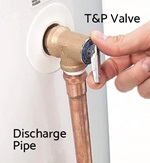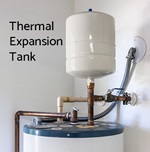Water Heater Safety
Even though we use hot water every day, we tend to forget about our hot water heaters – until the shower runs cold. But if not properly maintained, any water heater (electric, gas, or solar) can be a safety hazard. That’s because water expands greatly in volume when heated. Without a place to go, this extra volume also creates an increase in pressure. When a hot water heater is operating properly this expansion is accommodated for, but if components of the heater malfunction, thermal expansion becomes a real danger.
The Dangers of Thermal Expansion
The thermostat of a water heater normally maintains the tank’s water temperature at about 130º F (54º C). If the thermostat fails to shut off the heater, water temperature will continue to rise. If it goes above 212º F (100º C), it becomes super-heated. When super-heated water is suddenly exposed to the atmosphere, like when a faucet is opened, it instantly flashes into steam, which poses a serious scalding danger. And if the tank’s pressure continues to build, it could explode.
Protection from Thermal Expansion
Protection from thermal expansion is provided by two plumbing system components – temperature and pressure relief valves (T&P Valves), and thermal expansion tanks. Water heaters installed in compliance with current plumbing codes will have these components, but older homes may not. Regardless of age, these components and systems should be regularly inspected and tested by a qualified professional.
T&P Valves
 A temperature and pressure relief valve (T&P Valve) is a water heater’s primary safety feature. As the name suggests, this dual-function valve monitors water temperature and pressure in the hot water tank. It opens to release water if temperature nears 210º F (99º C), or pressure nears 125-150 psi. This lets cold water into the tank, reducing temperature and pressure to safe levels.
A temperature and pressure relief valve (T&P Valve) is a water heater’s primary safety feature. As the name suggests, this dual-function valve monitors water temperature and pressure in the hot water tank. It opens to release water if temperature nears 210º F (99º C), or pressure nears 125-150 psi. This lets cold water into the tank, reducing temperature and pressure to safe levels.
T&P Valves are designed to only operate in emergencies, so if you notice water discharge from your water heater, have it inspected immediately. They should be tested at least once a year to ensure they’re working properly.
To test a T&P Valve, gently open the lever on the top of the valve and verify hot water is expelled through the overflow pipe, which should drain onto the floor. If no water comes out during the test, or the valve drips after you’ve reset the lever, it should be replaced. You should refer to your water heater owner’s manual for detailed instructions.
Because of its critical role, many manufacturers recommend replacing T&P Valves every 5 years. This work should be entrusted to a qualified plumber.
Thermal Expansion Tanks
 A thermal expansion tank controls the increased pressure generated within the normal operating temperature range of the water heater. These small metal tanks, normally installed above or next to the water heater, provide a space for heated water to expand safely. They must be installed and maintained by a qualified plumber.
A thermal expansion tank controls the increased pressure generated within the normal operating temperature range of the water heater. These small metal tanks, normally installed above or next to the water heater, provide a space for heated water to expand safely. They must be installed and maintained by a qualified plumber.